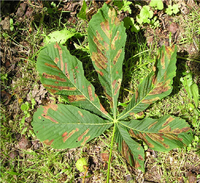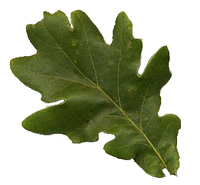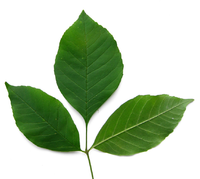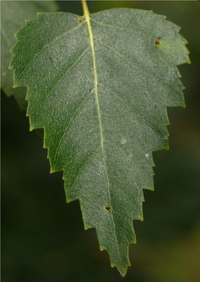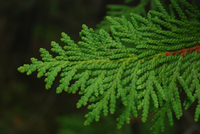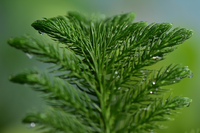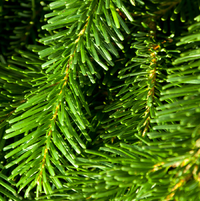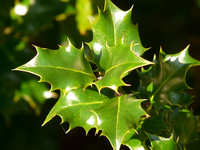Difference between revisions of "Leaf"
| Line 51: | Line 51: | ||
===About Leaves=== | ===About Leaves=== | ||
: The [[Cell (Biology)|cells]] in '''leaves''' have many [[chloroplast]]s inside them. | : The [[Cell (Biology)|cells]] in '''leaves''' have many [[chloroplast]]s inside them. | ||
| − | : '''Leaves''' produce food that is sent to the [[root]]s through the [[phloem]] which is a | + | : '''Leaves''' produce food that is sent to the [[root]]s through the [[phloem]] which is part of a [[Plant Vein]] that carries sap. |
'''Leaves''' have many tissues inside them found in layers: | '''Leaves''' have many tissues inside them found in layers: | ||
| − | *Upper Epidermis - A layer of cells at the top of the leaf that make | + | *Upper Epidermis - A layer of cells at the top of the leaf that make a waxy cuticle on top to keep the [[leaf]] [[waterproof]]. |
*[[Palisade Tissue]] - A layer of [[Palisade Cell|palisade cells]] which have lots of chloroplasts in them for photosynthesis. | *[[Palisade Tissue]] - A layer of [[Palisade Cell|palisade cells]] which have lots of chloroplasts in them for photosynthesis. | ||
*[[Spongy Mesophyll Tissue]] - A layer of [[Spongy Mesophyll Cell|spongy mesophyll cells]] that have irregular shapes to allow [[air]] to pass through the [[leaf]]. | *[[Spongy Mesophyll Tissue]] - A layer of [[Spongy Mesophyll Cell|spongy mesophyll cells]] that have irregular shapes to allow [[air]] to pass through the [[leaf]]. | ||
*Lower Epidermis - A layer of [[Cell (Biology)|cells]] at the bottom of the [[leaf]] with [[Stoma|stomata]] to allow [[air]] into and out of the [[leaf]]. | *Lower Epidermis - A layer of [[Cell (Biology)|cells]] at the bottom of the [[leaf]] with [[Stoma|stomata]] to allow [[air]] into and out of the [[leaf]]. | ||
| + | {| class="wikitable" | ||
| + | |- | ||
| + | |[[File:LeafCrossSectionDiagram.png|center|600px]] | ||
| + | |- | ||
| + | | style="height:20px; width:600px; text-align:center;" |A [[diagram]] of the cross section of a [[leaf]] showing [[Palisade Cell]]s, [[Spongy Mesophyll Cell]]s and [[Guard Cell]]s. | ||
| + | |} | ||
Revision as of 11:50, 13 September 2018
Contents
Key Stage 1
Meaning
A leaf is part of a plant that is joined to the stem above the ground.
About Leaves
Leaves are usually green and shaped like a blade or a needle. Some plants have red leaves and in some plants the leaves fall off in autumn.
Examples
| These are the leaves on a Horse Chestnut Tree. | This is a leaf from a Beech Tree | This is an Oak Tree leaf. |
| 3 leaves from an Ash Tree. | A Silver Birch Tree leaf. | These are the leaves of a Cedar Tree |
| These are the leaves of a Fir Tree. | These Pine Tree leaves are called Pine Needles. | These are the leaves of a Holly Tree. |
Key Stage 2
Meaning
The leaf is an organ in a plant used to make food by photosynthesis.
Adaptations
- The leaf is often wide and thin to collect as much sunlight as possible. The more sunlight it collects the more food it can make.
- The leaf has tubes called 'veins' inside it which carry the food away from the leaves to the roots and flower and to carry water into the leaf from the roots.
Key Stage 3
Meaning
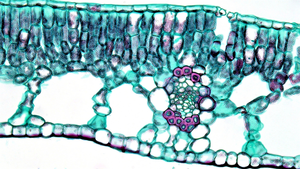
A cross section of a leaf.
A leaf is an organ in the shoot system of a plant that uses photosynthesis to produce food for the plant.
About Leaves
- The cells in leaves have many chloroplasts inside them.
- Leaves produce food that is sent to the roots through the phloem which is part of a Plant Vein that carries sap.
Leaves have many tissues inside them found in layers:
- Upper Epidermis - A layer of cells at the top of the leaf that make a waxy cuticle on top to keep the leaf waterproof.
- Palisade Tissue - A layer of palisade cells which have lots of chloroplasts in them for photosynthesis.
- Spongy Mesophyll Tissue - A layer of spongy mesophyll cells that have irregular shapes to allow air to pass through the leaf.
- Lower Epidermis - A layer of cells at the bottom of the leaf with stomata to allow air into and out of the leaf.
| A diagram of the cross section of a leaf showing Palisade Cells, Spongy Mesophyll Cells and Guard Cells. |
